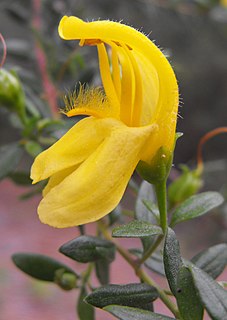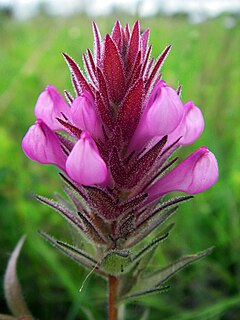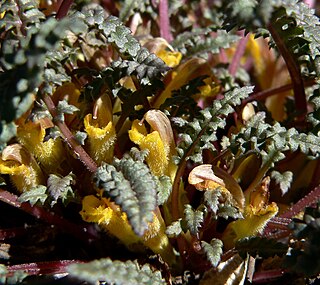
Keckiella antirrhinoides is a species of flowering shrub in the plantain family known by the common names snapdragon penstemon and chaparral beardtongue.

Keckiella corymbosa is a species of flowering shrub in the plantain family known by the common names redwood keckiella, red beardtongue, and red shrubby penstemon.

Acanthomintha lanceolata is a species of flowering plant in the mint family known by the common name Santa Clara thornmint. It is endemic to California, where it is known from several counties surrounding and south of the San Francisco Bay Area. It is an uncommon resident of rocky habitat in coastal and inland mountain ranges.
Collinsia corymbosa is a species of flowering plant in the plantain family known by the common name round-headed Chinese houses. It is endemic to the coastline of California north of the San Francisco Bay Area, where it is uncommon and scattered. Its habitat is the sand dunes of the immediate coastline. This is an annual herb producing a scaly, hairy, red to reddish green stem which grows upright or decumbent to a maximum length of about 25 centimeters. The thick, sparsely hairy leaves are rippled and lobed along the edges, which may be somewhat turned under. The inflorescence is a dense whorl of several distinctive flowers. Each has a hairy calyx of lobed reddish sepals and a corolla up to about 2 centimeters long. The flower has two small upper lobes and three longer lower lobes which come together in a nearly tubular shape. It is generally white with a light purple tint. The smaller upper lobes curl back and dry to brown at their lips.
Erigeron supplex is a rare species of flowering plant in the daisy family known by the common names supple daisy or supple fleabane. It grows along the coastline and in the Coast Ranges in California, north of San Francisco Bay. It probably remains only in Sonoma and Marin Counties. There is a report of it growing well inland in Shasta County, but this is from a farm and probably a cultivated specimen.
Diplacus pulchellus is an uncommon species of monkeyflower known by the common name yellowlip pansy monkeyflower. It was formerly known as Mimulus pulchellus.

Mohavea breviflora is a species of flowering plant in the plantain family known by the common names golden desert-snapdragon and lesser mohavea. It is native to the southwestern United States, including the Mojave Desert and surrounding areas. It is a hairy annual herb growing erect to a maximum height near 20 centimeters. The alternately arranged leaves are lance-shaped. Flowers occur in the leaf axils. They are about 2 centimeters wide and divided into an upper lip with two lobes and a swollen lower lip with three. The flower is yellow with scattered red speckles.

Orthocarpus bracteosus is a species of flowering plant in the broomrape family known by the common name rosy owl's-clover. It is native to western North America from British Columbia to northern California, where it grows in moist mountain habitat, such as meadows.

Orthocarpus cuspidatus is a species of flowering plant in the broomrape family known by the common names Copeland's owl's clover, Siskiyou Mountains orthocarpus, and toothed owl's-clover. It is native to mountain and plateau habitat in Oregon, California, and Nevada. It is an annual herb producing a slender, glandular, hairy, purple-green stem up to about 40 centimeters tall. The narrow leaves are up to 5 centimeters long, the upper ones deeply divided into three linear lobes. The inflorescence is a dense cylindrical spike of wide, oval green bracts with pinkish points. The flowers emerge from between the bracts. Each purple-pink flower is fuzzy in texture and club-shaped, the lower lip an expanded pouch and the upper lip a narrow, straight beak.

Orthocarpus imbricatus is a species of flowering plant in the broomrape family known by the common name mountain owl's-clover. It is native to western North America from British Columbia to northern California, where it grows in meadows and other mountain habitat.

Orthocarpus luteus is a species of flowering plant in the broomrape family known by the common name yellow owl's-clover. It is native to much of western and central North America, where it grows in many types of plateau, grassland, and mountain habitat.

Pedicularis centranthera is a species of flowering plant in the family Orobanchaceae known by the common names dwarf lousewort and Great Basin lousewort. It is native to the western United States from eastern Oregon and California to Colorado and New Mexico, where it grows in sagebrush and other basin and plateau habitat. It is a perennial herb producing several short stems a few centimeters tall from a basal caudex. The leaves are up to 20 centimeters long, lance-shaped and divided into many overlapping toothed, wrinkled, or fringed lobes. The inflorescence is a short raceme bearing many long, protruding, club-shaped flowers. Each flower may exceed 4 centimeters in length and is white or pale purple with dark purple tips on the wide ends of its upper and lower lips. The sepals of the flowers are shorter and hairy. The fruit is a capsule around centimeter long containing seeds with netlike surfaces.
Pedicularis howellii is an uncommon species of flowering plant in the family Orobanchaceae known by the common name Howell's lousewort. It is endemic to the Siskiyou Mountains of the Klamath Range in southern Oregon and northern California, where it grows on the edges of coniferous forests. This is a perennial herb producing one or more stems up to 45 centimetres (18 in) tall from a long caudex. The leaves are up to 20 centimetres (8 in) long, lance-shaped, and divided into many toothed oval lobes; those higher on the stem may be unlobed. The basal leaves fall away early. The inflorescence is a small raceme of flowers occupying the top of the stem. Each white to light purple flower is up to one centimetre long and is sickle-shaped, with a curved beak-like upper lip and a three-lobed lower lip which may be tucked into the hairy mass of sepals. The plant is pollinated by bumblebees including Bombus mixtus. Between the flowers are hairy to woolly triangular bracts. The fruit is a capsule just under a centimeter long containing seeds with netted surfaces.

Pedicularis semibarbata, known by the common name pinewoods lousewort, is a species of flowering plant in the family Orobanchaceae.
Penstemon personatus is an uncommon species of penstemon known by the common name closethroat beardtongue.

Triphysaria eriantha is a species of flowering plant in the family Orobanchaceae, known by the common names johnny-tuck and butter-and-eggs.

Triphysaria floribunda is a rare species of flowering plant in the family Orobanchaceae known by the common name San Francisco owl's-clover. It is endemic to California, where it is known only from the San Francisco Bay Area. It is limited to coastal regions of Marin, San Francisco, and San Mateo Counties, where it occurs in coastal prairie habitats, sometimes on serpentine soils.
Triphysaria micrantha is a species of flowering plant in the family Orobanchaceae known by the common name purplebeak owl's-clover. It is endemic to California, where it is known from the grasslands of the Central Valley and the foothills to the east and west. It an annual herb producing a hairy, glandular, purple-colored stem up to about 15 centimeters in maximum height. Like many species in its family it is a facultative root parasite on other plants, attaching to their roots via haustoria to tap nutrients. Its greenish to red-purple leaves are up to 2.5 centimeters long and are sometimes divided into a few narrow, pointed lobes. The inflorescence is a spike of flowers a few centimeters in length. Each flower has a narrow purple upper lip and a wide lower lip which is divided into yellowish or white pouches, often with purple markings on the lower parts.

Triphysaria pusilla is a species of flowering plant in the family Orobanchaceae known by the common name dwarf owl's-clover.
Phyllostegia hirsuta is a species of flowering plant in the mint family known by the common names Molokai phyllostegia and hairy phyllostegia. It is endemic to Hawaii, where it is known only from the island of Oahu. It is a federally listed endangered species of the United States.













